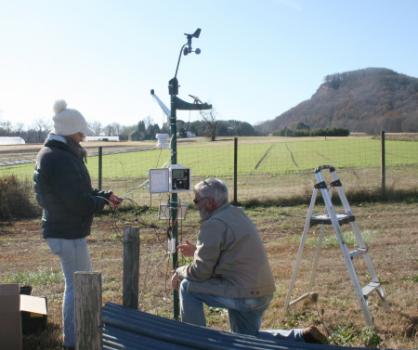When the decade-old weather station at the UMass Crop and Animal Research and Education Farm in South Deerfield was hit by lightning this past summer, the impact of that loss was felt by the region’s growers. This November, UMass fruit extension educators Jon Clements and Liz Garofalo replaced the decade-old defunct weather station with a new one.
Years ago, growers had to depend on their old farm records and their best guesses to reckon how much rain would grace their fields or how much wind would blow across their crops. Of key importance to farmers are factors like temperature, relative humidity, solar radiation and leaf wetness. These dynamics interplay with each other to determine how and when to plant seasonal crops. Properly forecasting weather events directs timing of actions to ensure proper Integrated Pest Management (IPM) occurs. Growers have become increasingly dependent on data obtained from weather stations: they are foundational to grow healthy crops.
Jon Clements is clear about the value of weather stations. He says, “If you are not monitoring weather on your farm, you are not fully practicing IPM.” The accumulated wisdom that growers amass over time is no match for varying effects of climate change. Determining planting schedules, predicting the arrival of pests, and timing harvests are just guessing games unless growers have access to daily, and sometimes hourly, weather data.
Clements explained that this weather station is part of a wider network through the northeast and Midwest called Network for Environment and Weather Applications (NEWA). Cornell University manages the network and UMass has helped to install stations on farms around the Commonwealth for a total of 27. Installation and oversight is one of Jon Clements duties as NEWA state coordinator.
Who taps into weather stations besides growers, you may wonder? Garofalo explains that researchers and extension educators who are both interested in climate change data and IPM guidance are frequent users. She goes on to say, “Farm workers need to know the life cycle of pests and those who monitor pest traps have to know when it’s optimum timing to apply crop protectants, so they check in on weather station data several times a day. Even issues like leaf wetness can drive decisions to take critical steps to limit potential for crop infection.
